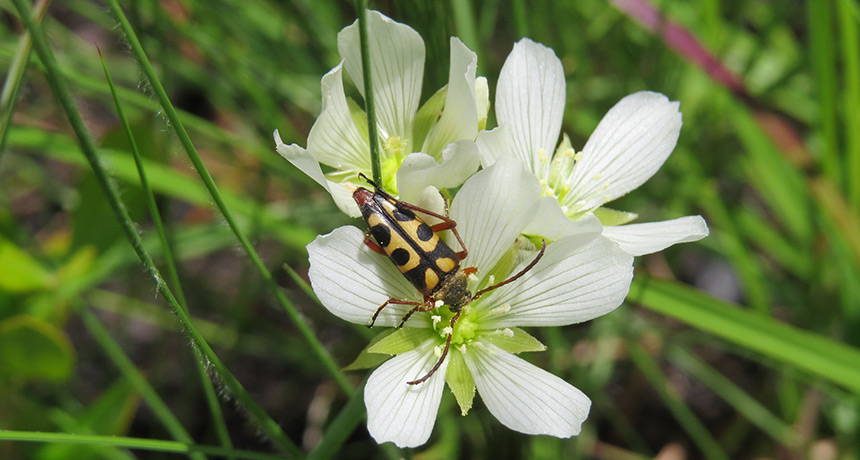Venus flytraps tend not to eat their pollinators
Little overlap found among critters that serve as pollinator and prey

The notch-tipped flower longhorn beetle was one of the most common species found on Venus flytrap flowers.
C. SORENSON
A Venus flytrap requires a pollinator to make seeds and reproduce. But who those pollinators are have long remained a mystery. One reason: Scientists and gardeners tend to focus on the carnivorous plant’s clever traps. Now researchers have finally looked at which species visit the plant’s delicate white flowers. And they’ve found little overlap with species that serve as the plant’s meals.
There are hundreds of species of carnivorous plants found across the planet. Few, however, attract quite as much fascination as the Venus flytrap. The plants are native to just a small section of North Carolina and South Carolina. But these tiny plants can now be found around the world. They’re a favorite among gardeners, who grow them in homes and greenhouses.
Although scientists have extensively studied the famous trap, they’ve largely ignored the flower that blooms atop a stalk 15 to 35 centimeters (9 to 14 inches) high. That means they’ve also largely missed seeing what pollinates that flower.
“The rest of the plant is so incredibly cool that most folks don’t get past looking at the active trap leaves,” says Clyde Sorenson. He’s an entomologist, or insect biologist, at North Carolina State University in Raleigh.
Because flytraps grow in such a small area of the Carolinas, field studies can be difficult, adds Elsa Youngsteadt. She’s an insect ecologist, also at NCSU. And there’s another problem when studying flytrap pollination. Most people who raise these plants cut off their flowers. Why? It helps the plant put more of its energy into making traps.
Sorenson and Youngsteadt realized that the answer to what pollinates these flytraps was sitting almost literally in their backyard. So they started sleuthing.
Tallying pollinators and prey
Their team collected flytrap flower visitors and prey on four days in May and June 2016. All came from three sites in Pender County, N.C.

“This is one of the prettiest places where you could work,” Youngsteadt says. Venus flytraps are habitat specialists. They’re found only in certain spots of longleaf pine savannas in the Carolinas.
“They need plenty of sunlight but like their feet to be wet,” notes Sorenson. In May and June, the spots where the flytraps grow are “just delightful,” he says. Other carnivorous plants show up there, too. These include pitcher plants and sundews.
The researchers brought their finds back to the lab for identification. They also catalogued what kind of pollen the blooms’ visitors picked up — and how much.
Arthropods include a range of invertebrate animals, including insects, spiders and centipedes. Nearly 100 different arthropod species visited the flowers, the team reports February 5 in American Naturalist. “The diversity of visitors,” says Youngsteadt, “was surprising.” However, only three species — a sweat bee and two beetles — appeared especially important. They were either the most frequent visitors or had carried the most pollen.
Only 13 species were found both in a trap and on a flower. And of nine potential pollinators in that group, none was trapped in high numbers. For a carnivorous plant, “you don’t want to eat your pollinators,” Sorenson says. His team’s data now suggests flytraps do a good job of sparing their helpers.
Keeping pollinator and prey separate
There are three ways that a plant can keep pollinators and prey separate, the researchers note.
Flowers and traps could exist at different times of the year. However, that’s not the case with Venus flytraps. Traps develop earlier but stick around and are active during plant flowering.
The traps and blooms could also be spaced far apart. Pollinators tend to be fliers while prey were more often crawlers, such as spiders and ants. This matches up with the high flowers and low traps. But the researchers would like to do some experiments that manipulate the heights of the structures, Youngsteadt says. That would let them see just how much that separation matters.
The third option is that different scents or colors might lure different species to the flowers and traps. That’s another area for future study, Youngsteadt says. While scent and color are known attractants for the traps, little is known about whether those factors lure in pollinators.
Venus flytraps are considered vulnerable to extinction, Sorenson notes. The plant’s habitat is being destroyed as housing and other developments expand into their areas. What is left of that habitat is being degraded as fires are suppressed. (Fires help clear vegetation and keep sunlight shining on the flytraps.) Finally, people steal flytraps from the wild by the thousands.
While research into flytrap pollinators won’t hold off any of those threats, it could aid in future conservation efforts. “Anything we can do to better understand how this plant reproduces will be of use down the road,” Sorenson says.
But what really excites the scientists is that they discovered something new so close to home. “One of the most thrilling parts of all this,” Sorenson says, “is that this plant has been known to science for [so long], everyone knows it, but there’s still a whole lot of things to discover.”







